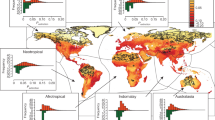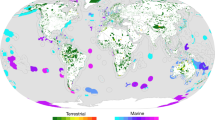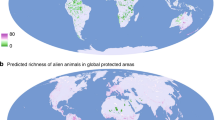Abstract
Recent assessments of Earth’s dwindling wilderness have emphasized that Antarctica is a crucial wilderness in need of protection1,2. Yet human impacts on the continent are widespread3,4,5, the extent of its wilderness unquantified2 and the importance thereof for biodiversity conservation unknown. Here we assemble a comprehensive record of human activity (approximately 2.7 million records, spanning 200 years) and use it to quantify the extent of Antarctica’s wilderness and its representation of biodiversity. We show that 99.6% of the continent’s area can still be considered wilderness, but this area captures few biodiversity features. Pristine areas, free from human interference, cover a much smaller area (less than 32% of Antarctica) and are declining as human activity escalates6. Urgent expansion of Antarctica’s network of specially protected areas7 can both reverse this trend and secure the continent’s biodiversity8,9,10.
This is a preview of subscription content, access via your institution
Access options
Access Nature and 54 other Nature Portfolio journals
Get Nature+, our best-value online-access subscription
$29.99 / 30 days
cancel any time
Subscribe to this journal
Receive 51 print issues and online access
$199.00 per year
only $3.90 per issue
Buy this article
- Purchase on Springer Link
- Instant access to full article PDF
Prices may be subject to local taxes which are calculated during checkout



Similar content being viewed by others
Data availability
The wilderness areas and historical human activity data are available at https://doi.org/10.26180/5c32bf1b041ea. The other spatial data can be obtained from their creators18,28,53,68.
Code availability
Computer code is available at https://doi.org/10.26180/5c32bf1b041ea.
References
Mittermeier, R. A. et al. Wilderness and biodiversity conservation. Proc. Natl. Acad. Sci. USA 100, 10309–10313 (2003).
Watson, J. E. M. et al. Protect the last of the wild. Nature 563, 27–30 (2018).
Chown, S. L. et al. The changing form of Antarctic biodiversity. Nature 522, 431–438 (2015).
Rintoul, S. R. et al. Choosing the future of Antarctica. Nature 558, 233–241 (2018).
Pertierra, L. R., Hughes, K. A., Vega, G. C. & Olalla-Tárraga, M. Á. High resolution spatial mapping of human footprint across Antarctica and its implications for the strategic conservation of avifauna. PLoS One 12, e0168280 (2017).
Hughes, K. A., Fretwell, P., Rae, J., Holmes, K. & Fleming, A. Untouched Antarctica: mapping a finite and diminishing environmental resource. Antarct. Sci. 23, 537–548 (2011).
Secretariat of the Antarctic Treaty. Protocol on Environmental Protection to the Antarctic Treaty https://www.ats.aq/e/protocol.html (Antarctic Treaty Secretariat, 1991).
Coetzee, B. W. T., Convey, P. & Chown, S. L. Expanding the protected area network in Antarctica is urgent and readily achievable. Conserv. Lett. 10, 670–680 (2017).
Keys, H. Towards Additional Protection of Antarctic Wilderness Areas https://documents.ats.aq/ATCM23/ip/ATCM23_ip080_e.doc (submitted by the Government of New Zealand, Doc. IP80, ATCM XXIII, 1999).
Summerson, R. & Tin, T. Twenty years of protection of wilderness values in Antarctica. Polar J. 8, 265–288 (2018).
Di Marco, M., Ferrier, S., Harwood, T. D., Hoskins, A. J. & Watson, J. E. M. Wilderness areas halve the extinction risk of terrestrial biodiversity. Nature 573, 582–585 (2019).
Cole, D. N. & Landres, P. B. Threats to wilderness ecosystems: impacts and research needs. Ecol. Appl. 6, 168–184 (1996).
Watson, J. E. M. et al. Catastrophic declines in wilderness areas undermine global environment targets. Curr. Biol. 26, 2929–2934 (2016).
Lim, E. et al. Australian hot and dry extremes induced by weakenings of the stratospheric polar vortex. Nat. Geosci. 12, 896–901 (2019).
Summerson, R. & Riddle, M. J. in Antarctic Ecosystems: Models for Wider Ecological Understanding (eds Davison, W. et al.) 303–307 (New Zealand Natural Sciences, Christchurch, 2000).
Bastmeijer, K. & van Hengel, S. The role of the protected area concept in protecting the world’s largest natural reserve: Antarctica. Utrecht Law Rev. 5, 61–79 (2009).
Chown, S. L. et al. Antarctica and the strategic plan for biodiversity. PLoS Biol. 15, e2001656 (2017).
Brooks, S. T., Jabour, J., van den Hoff, J. & Bergstrom, D. M. Our footprint on Antarctica competes with nature for rare ice-free land. Nat. Sustain. 2, 185–190 (2019).
Hughes, K. A. et al. Human-mediated dispersal of terrestrial species between Antarctic biogeographic regions: a preliminary risk assessment. J. Environ. Manage. 232, 73–89 (2019).
Lee, J. R. et al. Climate change drives expansion of Antarctic ice-free habitat. Nature 547, 49–54 (2017).
Hughes, K. A., Cowan, D. A. & Wilmotte, A. Protection of Antarctic microbial communities—‘out of sight, out of mind’. Front. Microbiol. 6, 151 (2015).
Hughes, K. A. et al. Pristine Antarctica: threats and protection. Antarct. Sci. 25, 1 (2013).
Shaw, J. D., Terauds, A., Riddle, M. J., Possingham, H. P. & Chown, S. L. Antarctica’s protected areas are inadequate, unrepresentative, and at risk. PLoS Biol. 12, e1001888 (2014).
Secretariat of the Antarctic Treaty. Antarctic Protected Areas Database https://www.ats.aq/devph/en/apa-database (2019).
Committee for Environmental Protection (CEP). Understanding Concepts of Footprint and Wilderness Related to Protection of the Antarctic Environment https://documents.ats.aq/ATCM34/wp/ATCM34_wp035_e.doc (submitted by the Government of New Zealand, Doc. WP35, ATCM XXXIV, 2011).
Committee for Environmental Protection (CEP). Annex V Inviolate and Reference Areas: Current Management Practices https://documents.ats.aq/ATCM35/ip/ATCM35_ip049_e.doc (submitted by ASOC, IP 49, ATCM XXXV, 2012).
Committee for Environmental Protection (CEP). Report of the Twenty-second Meeting of the Committee for Environmental Protection https://documents.ats.aq/ATCM42/fr/ATCM42_fr001_e.pdf (CEP, 2019).
Terauds, A. & Lee, J. R. Antarctic biogeography revisited: updating the Antarctic Conservation Biogeographic Regions. Divers. Distrib. 22, 836–840 (2016).
Council of Managers of National Antarctic Programs. Antarctic Facilities Operated by National Antarctic Programs in the Antarctic Treaty Area (South of 60° Latitude South) version 3.0.1 https://www.comnap.aq (COMNAP, accessed 8 August 2018).
Tin, T., Liggett, D., Maher, P. T. & Lamers, M. (eds) Antarctic Futures: Human Engagement with the Antarctic Environment (Springer, Dordrecht, 2014).
Dingwall, P. R. (ed.) Antarctica in the Environmental Era (Department of Conservation, Wellington, 1998).
Summerson, R. in Protection of the Three Poles (ed. Huettmann, F.) 77–109 (Springer, Tokyo, 2012).
Brooks, S. T., Tejedo, P. & O’Neill, T. A. Insights on the environmental impacts associated with visible disturbance of ice-free ground in Antarctica. Antarct. Sci. 31, 304–314 (2019).
O’Neill, T. A., Balks, M. R. & López-Martínez, J. Visual recovery of desert pavement surfaces following impacts from vehicle and foot traffic in the Ross Sea region of Antarctica. Antarct. Sci. 25, 514–530 (2013).
Convey, P. The influence of environmental characteristics on life history attributes of Antarctic terrestrial biota. Biol. Rev. Camb. Philos. Soc. 71, 191–225 (1996).
Ayres, E. et al. Effects of human trampling on populations of soil fauna in the McMurdo Dry Valleys, Antarctica. Conserv. Biol. 22, 1544–1551 (2008).
Convey, P., Hughes, K. A. & Tin, T. Continental governance and environmental management mechanisms under the Antarctic Treaty System: sufficient for the biodiversity challenges of this century? Biodiversity (Nepean) 13, 234–248 (2012).
Chown, S. L. & Brooks, C. M. The state and future of Antarctic environments in a global context. Annu. Rev. Environ. Res. 44, 1–30 (2019).
Brooks, C. M. et al. Science-based management in decline in the Southern Ocean. Science 354, 185–187 (2016).
Secretariat of the Antarctic Treaty. Revised Guidelines for Environmental Impact Assessment in Antarctica https://documents.ats.aq/recatt/Att605_e.pdf (Antarctic Treaty Secretariat, Buenos Aires, 2016).
Agence Nationale Recherche. East Antarctic International Ice Sheet Traverse (DS0101) https://anr.fr/Project-ANR-16-CE01-0011 (ANR, France, 2016).
Harris, C. M. et al. Important Bird Areas in Antarctica 2015 (BirdLife International and Environmental Research & Assessment Ltd., Cambridge, 2015).
Cowan, D. A. et al. Non-indigenous microorganisms in the Antarctic: assessing the risks. Trends Microbiol. 19, 540–548 (2011).
Montross, S. et al. Debris-rich basal ice as a microbial habitat, Taylor Glacier, Antarctica. Geomicrobiol. J. 31, 76–81 (2014).
Archer, S. D. J. et al. Airborne microbial transport limitation to isolated Antarctic soil habitats. Nat. Microbiol. 4, 925–932 (2019).
Fretwell, P. T., Convey, P., Fleming, A. H., Peat, H. J. & Hughes, K. A. Detecting and mapping vegetation distribution on the Antarctic Peninsula from remote sensing data. Polar Biol. 34, 273–281 (2011).
Schwaller, M. R., Lynch, H. J., Tarroux, A. & Prehn, B. A continent-wide search for Antarctic petrel breeding sites with satellite remote sensing. Remote Sens. Environ. 210, 444–451 (2018).
Duffy, G. A. et al. Barriers to globally invasive species are weakening across the Antarctic. Divers. Distrib. 23, 982–996 (2017).
Consultative Parties to the Antarctic Treaty. Santiago Declaration https://www.ats.aq/documents/ATCM39/ad/atcm39_ad003_e.pdf (Antarctic Treaty Secretariat, Buenos Aires, 2016).
Pebesma, E. J. & Bivand, R. S. Classes and methods for spatial data in R. R News 5, 9–13 (2005).
R Core Team. R: a language and environment for statistical computing (R Foundation for Statistical Computing, Vienna, 2017).
Environmental Systems Research Institute (ESRI). ArcGIS Desktop, release 10.6 (Environmental Systems Research Institute, Redlands, CA, 2011).
Scientific Committee on Antarctic Research (SCAR). Antarctic Digital Database version 7 https://www.add.scar.org/ (2018).
Headland, R. K. Chronological List of Antarctic Expeditions and Related Historical Events (Cambridge Univ. Press, Cambridge, 1989).
Scientific Committee on Antarctic Research. Composite Gazetteer of Antarctica https://data.aad.gov.au/aadc/gaz/scar/ (GCMD Metadata, 1992, updated 2014).
Evans, J. S. spatialEco. R package version 0.0.1-7 https://CRAN.R-project.org/package=spatialEco (2017).
Hijmans, R. J. raster: geographic data analysis and modeling. R package version 2.6-7 https://CRAN.R-project.org/package=raster (2017).
Hughes, K. A. How committed are we to monitoring human impacts in Antarctica? Environ. Res. Lett. 5, 041001 (2010).
Bivand, R., Keitt, T. & Rowlingson, B. rgdal: bindings for the ‘geospatial’ data abstraction library. R package version 1.3-4 https://CRAN.R-project.org/package=rgdal (2018).
International Association of Antarctica Tour Operators (IAATO). 2017–2018 Tourism Statistics http://iaato.org/tourism-statistics (IAATO, accessed 29 October 2018).
United States Antarctic Program (USAP). USAP Science Planning Summaries 2003–2016 https://www.usap.gov/sciencesupport/2179/ (USAP, 2019).
Bargagli, R. Antarctic Ecosystems: Environmental Contamination, Climate Change, and Human Impact (Springer, Berlin, 2005).
Hughes, K. A. & Convey, P. The protection of Antarctic terrestrial ecosystems from inter- and intra-continental transfer of non-indigenous species by human activities: a review of current systems and practices. Glob. Environ. Change 20, 96–112 (2010).
Campbell, I. B., Claridge, G. G. C. & Balks, M. R. Short-and long-term impacts of human disturbances on snow-free surfaces in Antarctica. Polar Rec. (Gr. Brit.) 34, 15–24 (1998).
Tejedo, P. et al. Soil trampling in an Antarctic Specially Protected Area: tools to assess levels of human impact. Antarct. Sci. 21, 229–236 (2009).
Chown, S. L. et al. Continent-wide risk assessment for the establishment of nonindigenous species in Antarctica. Proc. Natl. Acad. Sci. USA 109, 4938–4943 (2012).
Duffy, G. A. & Lee, J. R. Ice-free area expansion compounds the non-native species threat to Antarctic terrestrial biodiversity. Biol. Conserv. 232, 253–257 (2019).
Antarctica New Zealand. McMurdo Dry Valleys ASMA Manual 4th edn (Christchurch, New Zealand, 2015).
BirdLife International. Antarctic Important Bird Areas http://datazone.birdlife.org/home (BirdLife International, Cambridge, 2018).
Terauds, A. Antarctic Terrestrial Biodiversity Database (Australian Antarctic Data Centre, 2019).
Casanovas, P., Black, M., Fretwell, P. & Convey, P. Mapping lichen distribution on the Antarctic Peninsula using remote sensing, lichen spectra and photographic documentation by citizen scientists. Polar Res. 34, 25633 (2015).
Fretwell, P. T. et al. An emperor penguin population estimate: the first global, synoptic survey of a species from space. PLoS One 7, e33751 (2012).
Wauchope, H. S., Shaw, J. D. & Terauds, A. A snapshot of biodiversity protection in Antarctica. Nat. Commun. 10, 946 (2019).
Lynch, H. J., Naveen, R. & Fagan, W. F. Censuses of penguin, blue-eyed shag Phalacrocorax atriceps and southern giant petrel Macronectes giganteus populations on the Antarctic Peninsula, 2001-2007. Mar. Ornithol. 36, 83–97 (2008).
Burton-Johnson, A., Black, M., Fretwell, P. & Kaluza-Gilbert, J. An automated methodology for differentiating rock from snow, clouds and sea in Antarctica from Landsat 8 imagery: a new rock outcrop map and area estimation for the entire Antarctic continent. Cryosphere 10, 1665–1677 (2016).
Acknowledgements
We thank K. Close, G. A. Duffy, R. Harvey, K. A. Hughes, T. Robertson and D. Smith for their assistance in identifying activity data and M. A. McGeoch, H. P. Baird, J. R. Lee, L. Chapman and A. Clarke for reading a previous version of this manuscript. This research was supported by Australian Antarctic Science (AAS) grant 4482 and a Sir James McNeill Foundation Postgraduate Research Scholarship to R.I.L. F.M. was supported by a New Zealand Ministry of Business, Innovation and Employment grant (CO9X1413). A.T. was supported by AAS grant 4296.
Author information
Authors and Affiliations
Contributions
S.L.C., B.W.T.C. and R.I.L. conceived the study. R.I.L., B.W.T.C., F.M., B.R., J.D.S. and A.T. collected the human activity data. R.I.L. conducted the analyses. R.I.L., K.B. and S.L.C. drafted the initial manuscript. All authors contributed to the final manuscript.
Corresponding author
Ethics declarations
Competing interests
S.L.C. is the President of the Scientific Committee on Antarctic Research.
Additional information
Peer review information Nature thanks Andrew Clarke and the other, anonymous, reviewer(s) for their contribution to the peer review of this work.
Publisher’s note Springer Nature remains neutral with regard to jurisdictional claims in published maps and institutional affiliations.
Extended data figures and tables
Extended Data Fig. 1 Cumulative impact of human visitation across Antarctica.
a, Weighted relative impact (WRI) scores of the number of independent historical human visitation records per 25-km2 grid cell, weighted by the proportion of ice-free area in each cell and the eight adjacent cells. Visitation to sites with WRI scores ≤20 is likely to have had a negligible impact. Cells without WRI scores (grey) have no historical visitation record in the data set and are considered here as unvisited. b, WRI scores for the McMurdo Dry Valleys region. c, Location of 18 field camps (points) in the McMurdo Dry Valleys, used to validate the WRI scores (Extended Data Table 2). d, Frequency distribution of 1,999 bootstrapped binomial generalized linear model regression coefficients for the relationship between WRI scores and the presence/absence of field camps in the McMurdo Dry Valleys (b, c; n = 252 grid cells). The dashed line indicates the regression coefficient (0.0023) for the model fit to the original sample.
Extended Data Fig. 2 Historical human visitation record density.
a, b, Number of historical human activity records (a) and number of independent historical human activity records (b) per 50 × 50 km cell across Antarctica from 1819 to 2018 (n = 2,698,429 records). Dark purple lines (a) indicate the routes of recent overland traverses (for example, 2007–2008 Norwegian–US Scientific Traverse of East Antarctica), where geo-positioning data were collected automatically at high temporal resolutions (~10 min), resulting in many records for relatively transitory site visits. To standardize sampling frequencies across different data sources, independent records (b) count only one record per cell per data set for data sets describing a single event (for example, a traverse).
Extended Data Fig. 3 Sampling completeness and scale dependency of visitation records.
a, Relationship between the number of visitation records and percentage of land area visited across Antarctica at a 25-km2 grid resolution, modelled using a power-law model (f(x) = 0.78x0.39; r2 = 0.99). The visitation accumulation curve is extrapolated (dashed line) to predict the percentage land area expected to be identified as visited if twice the number of visitation records (5.4 million records) were available in the data set. Points indicate the percentage of visited land, calculated using 20 random subsamples of the complete visitation records for each interval (n = 240 subsamples); shaded blue area indicates 95% confidence interval. b, Relationship between grid cell resolution and the percentage of land area across Antarctica with no visitation records (that is, unvisited areas), modelled using an exponential model (f(x) = 91.78e(–0.01x); r2 = 0.95; n = 15 grids). In this study, visitation was modelled at a 5-km (25-km2) resolution (square).
Supplementary information
Rights and permissions
About this article
Cite this article
Leihy, R.I., Coetzee, B.W.T., Morgan, F. et al. Antarctica’s wilderness fails to capture continent’s biodiversity. Nature 583, 567–571 (2020). https://doi.org/10.1038/s41586-020-2506-3
Received:
Accepted:
Published:
Issue Date:
DOI: https://doi.org/10.1038/s41586-020-2506-3
This article is cited by
-
Biogeographic survey of soil bacterial communities across Antarctica
Microbiome (2024)
-
Untangling unexpected terrestrial conservation challenges arising from the historical human exploitation of marine mammals in the Atlantic sector of the Southern Ocean
Ambio (2023)
-
Reimagining the wilderness ethic to include “people and nature”
Biodiversity and Conservation (2022)
-
Transforming Antarctic management and policy with an Indigenous Māori lens
Nature Ecology & Evolution (2021)
-
Towards an Environmental Classification of Lentic Aquatic Ecosystems in the McMurdo Dry Valleys, Antarctica
Environmental Management (2021)
Comments
By submitting a comment you agree to abide by our Terms and Community Guidelines. If you find something abusive or that does not comply with our terms or guidelines please flag it as inappropriate.



